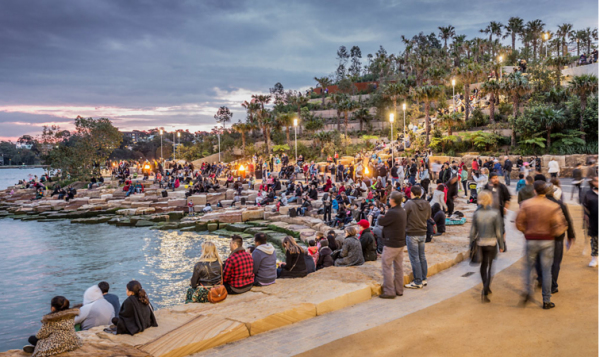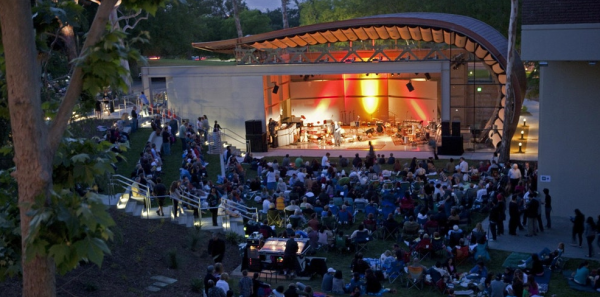A new survey about the local art scene reveals little that distinguishes it from the conclusions of two previous studies: residents have a strong desire for Laguna Beach to be known as an arts community with a walkable scale and a cultural center.
Respondents to the new survey stated their desires for piazzas, pocket parks and meeting places, similar to findings of two other city surveys made in 2016 and in 2001.

Results indicated strong support for a “town-center,” a desire for spaces and activities to “attract younger and more culturally diverse audiences,” and a “raising of the bar on the quality of public art.” The need for a high quality music venue was repeatedly mentioned in respondent’s comments.
“The next step is to review needs and demands, the pros and cons those needs would have on the community and identify short and long-term goals,” city cultural arts manager Sian Poeschl said. She anticipates additional surveys and questionnaires. “We have a long way to go, but there is a sense that the community would like a central place to meet where they know there are cultural opportunities to participate in, and that doesn’t necessarily require that a building be large or be expensive to facilitate,” she added.
The report was discussed in a Jan. 20 meeting, Poeschl said.
The report suggests making use of under-used or empty commercial buildings and privately owned facilities to expand performance space. Suggested buildings included the South Coast Cinema, the Wells Fargo building, Laguna Drug and a local church among others.
The new survey also detected some dissatisfaction with the arts as “stale” and concluded that Laguna lacks enough performance and rehearsal spaces for existing organizations. “We can’t grow,” said Jodi Gates, founder and artistic director of the Laguna Dance Festival. “It’s critical to our survival to get a venue,” she said in a telephone interview, adding that she has been approached by world-class ballet companies interested in doing month-long residencies in Laguna, but has had to turn them away.
Laguna Dance Festival, which holds performances at Laguna Playhouse, was one of 13 local arts organizations identified in the survey as lacking a permanent home.
Carol Reynolds, board member of music presenter Laguna Beach Live!, which holds its shows in at least three different locations in town, also reiterated the need for more facilities to accommodate performing arts and to broaden the town’s focus beyond its emphasis on visual arts. “We need to lobby harder; we need an advocate for music,” she said.

Sam Goldstein, also a Laguna Beach Live! board member, called the lack of performance space “a tragedy.”
The new survey, conducted by New York based AEA Consulting, was commissioned last summer to deliver a “creative place-making assessment” of Laguna Beach. Its findings were released last month.
“The assessment compiled an inventory of cultural activities, organizations and existing venues and evaluated how well they serve the needs of local artists and cultural arts organizations,” City Council member Bob Whalen said. The report also made “recommendations as to how Laguna’s cultural programs could be enriched and improved whether through new and different types of events and programming, a more robust public arts program, a different utilization of existing venues or the creation of one or more new venues,” he added.
AEA held a town hall meeting attended by 61 residents and surveyed 47 arts leaders, elected and appointed officials, realtors, developers and others. An online survey of six arts organization administrators was also conducted with a follow up by AEA survey staff with three additional organizations.
The current survey differs from the 2016 version in one way: the older surveys called for live/work housing in the canyon; the current survey does not.
AEA’s survey found potential for year-round arts programming, noting “most activity happens between May and September.” The survey judged the Laguna Playhouse, the town’s largest indoor performance hall other than the high school theater, to be “overused,” with only 11 dark days per year and lacking in rehearsal space.
The overuse of the Playhouse “has taken its toll” and upgrades are needed there as well as at Art-A-Fair and at the Forum Theatre on the Festival of Arts grounds, the survey said.
Likewise, the survey noted that the most recently built community space, the Susi Q Center, to be “at capacity” and lacking an auditorium. Even so, the center “fills a gap” for arts organizations without a permanent home, the report said.
The Forum Theatre and Irvine Bowl, both on the recently revamped Festival of Arts’ grounds, need a “decreased rental-pricing scheme,” the report said. The outdoor Irvine Bowl’s 2,600 seats, home to the annual Pageant of the Masters production, rents for $3,000 per day and the 230-seat Forum Theatre at $550 per day. Both facilities are on publicly owned property leased to the Festival of Arts.
“We think the rates for subleasing the facilities are appropriate,” said spokeswoman Sharbie Higuchi, noting that rates are established through the Irvine Bowl policy committee, which includes two elected officials, city staff, festival board members and staff.
The report also evaluated potential for expanding programming at existing venues, including the Laguna College of Art and Design, the Laguna Art Museum, the Sawdust Festival and Art-a-Fair, but found them all lacking spaces for large gatherings.
“Whatever plan emerges will have both short-term and long-term elements to it and implementation will be an ongoing, multi-year effort,” said Whalen.
The stretch of South Coast Highway known as Sleepy Hollow, between Legion and Cleo Streets, with low pedestrian traffic and high retail vacancies, was identified as a district ripe for reinvigoration by the arts. “Using vacant space for pop-up cultural purposes and performances represents a means of serving artists while infusing new energy into the downtown,” the report said
In the long term, the study suggests development of a “mixed-use, indoor-outdoor performance venue that includes rehearsal space, meeting rooms and storage.” The report acknowledges the need for local approvals and funding for such an endeavor.
Other potential properties well-suited for development include the tennis courts at the FOA grounds, the parking lots near City Hall and the ACT V parking lot in Laguna Canyon, the report said.
AEA’s findings closely mirror those of the cultural arts plan commissioned by the city in 2016 to chart a 10-year plan. There are also similarities to the Vision 2030 report of 2001, compiled with input from 2,000 residents to develop a strategic plan to preserve the town’s character and co-exist with visitors.
The $121,000 price tag for the research conducted by AEA Consulting is underwritten by Business Improvement District revenue included in the city Arts Commission budget, Poeschl said. BID revenue, generated by a 2 percent portion of the city’s bed tax, is distributed to arts organizations and the city’s promotion arm.




